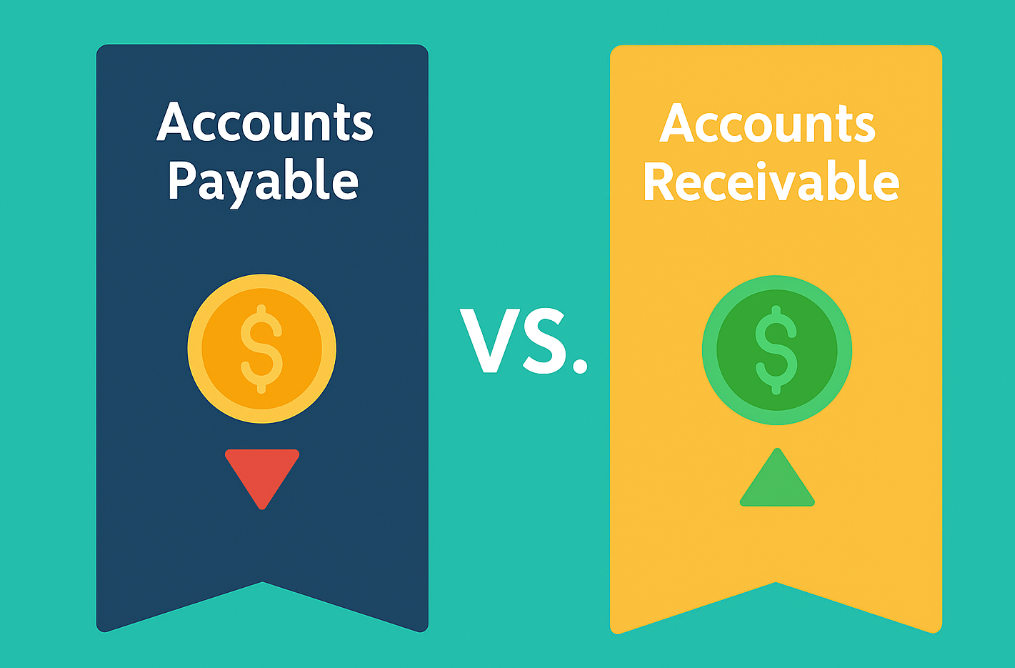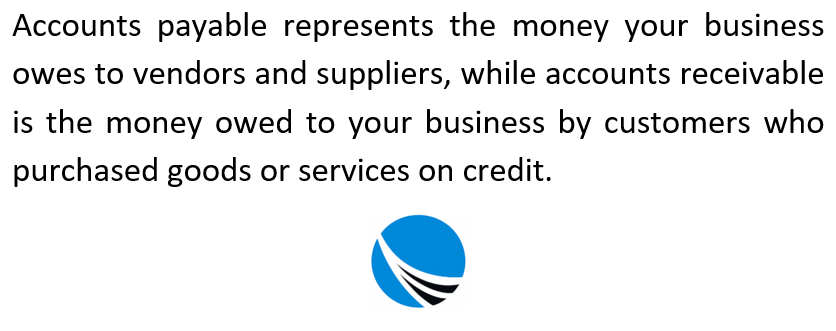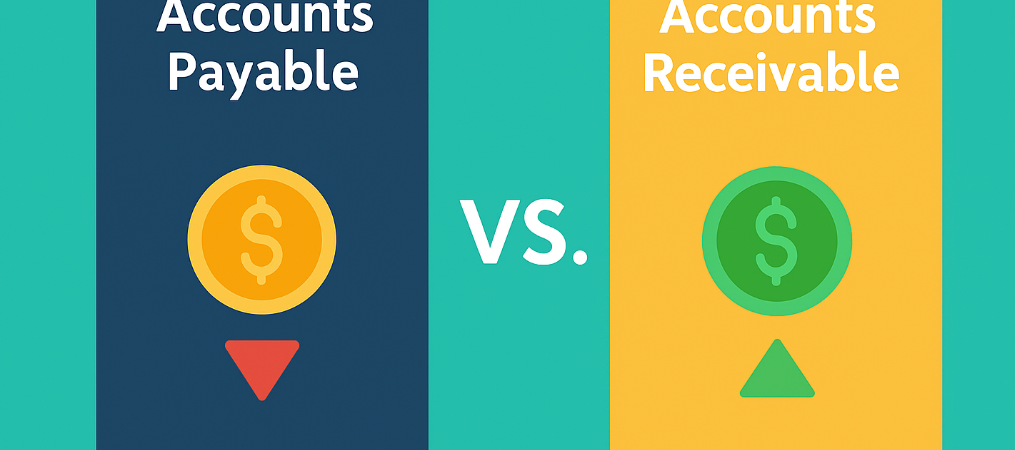For any business, whether large or small, managing cash flow efficiently is essential for sustainable growth. Two of the most important concepts that drive financial operations are accounts payable and accounts receivable. These terms define how money moves in and out of your company and have a direct impact on your bottom line.
While they may seem like basic accounting terms, mastering the processes behind them can help improve your financial planning, maintain healthy relationships with suppliers and customers, and enhance business resilience.

What Does Accounts Payable Mean?
Accounts payable (AP) refers to the amounts your company owes to external parties for goods or services already received but not yet paid for. These obligations are considered current liabilities on your balance sheet because they generally require payment within a short timeframe—usually 30 to 60 days.
For example, if you purchase office equipment from a vendor and receive an invoice with a 30-day payment term, that balance becomes part of your accounts payable. Common AP items include vendor bills, supply purchases, lease agreements, utility costs, and other operating expenses.
These transactions are typically recorded by increasing (crediting) the accounts payable account while simultaneously recording the associated expense (as a debit). Tracking these payables carefully helps ensure that your business avoids penalties, late fees, or strained vendor relationships.
Examples of Common Payables
Accounts payable transactions come in many forms. Here are some examples frequently encountered in daily operations:
- Purchasing goods from a supplier with deferred payment
- Renting business equipment or workspace
- Paying for raw materials used in production
- Settling travel expenses incurred by employees
- Covering transportation or shipping costs from vendors
While most of these are handled through the AP workflow, wages and employee-related payments usually fall under payroll systems and are treated separately in the accounting process.
Staying current with your payables is more than good bookkeeping—it reinforces credibility with your suppliers and helps manage cash outflows predictably.
What Is Accounts Receivable?
Accounts receivable (AR), on the other hand, reflects the income your business expects to collect from customers who have received your goods or services on credit. When you provide a product but allow the client to pay later, you create a receivable—an asset on your balance sheet.
Managing AR effectively means issuing timely invoices, tracking outstanding balances, and following up with customers when payments are overdue. This not only ensures steady cash flow but also keeps your books accurate and up to date.
For instance, if a consulting firm completes a project and issues a 15-day invoice to the client, that unpaid amount becomes part of its accounts receivable until it’s collected.
How Receivables Are Recorded
When your business sends an invoice for a credit-based sale, your general ledger should reflect an increase in accounts receivable (debit) and a corresponding increase in revenue (credit). When the customer settles the invoice, cash increases (debit), and accounts receivable decreases (credit).
If the sale also involves inventory, the cost of goods sold (COGS) is recorded, and the inventory account is reduced to reflect the transfer of goods.
Maintaining accurate AR records ensures you recognize revenue appropriately and avoid relying on income that hasn’t yet been received.
Key Differences Between Payables and Receivables
Accounts payable and receivable are two sides of the same coin, representing money flowing out and into your business. Understanding their differences is fundamental to managing financial obligations and assets.
- Accounts Payable: Represents money your business owes; considered a liability.
- Accounts Receivable: Represents money owed to your business; considered an asset.
In simple terms, AP is money going out (expenses), while AR is money coming in (revenue). A business must track both closely to monitor its financial health and ensure it has enough funds to meet obligations and support growth.
Comparative Snapshot
Let’s break down their distinctions further in a comparative table:
| Feature | Accounts Payable | Accounts Receivable |
|---|---|---|
| Definition | Money your business needs to pay | Money owed to your business |
| Role in Accounting | Liability | Asset |
| Timing | After receiving goods/services | After delivering goods/services |
| Examples | Vendor bills, leases, utilities | Client invoices, credit sales |
| Cash Flow Effect | Cash outflow | Cash inflow |
Early Payment and Collection Incentives
Managing the timing of your payables and receivables can unlock cost-saving and cash-enhancing opportunities.
Paying Invoices Early
Some suppliers offer discounts to businesses that pay before the standard due date. For example, a term like “2/10” means a 2% discount is available if the invoice is paid within 10 days. These discounts might seem minor on a single transaction, but over time, they can yield considerable savings and foster stronger supplier relationships.
When applying such a discount in your books, reduce the cash payment accordingly and record the discount separately to maintain accurate expense records.
Collecting Early Payments
To accelerate cash inflows, businesses may offer incentives for early payments from customers. These discounts—say, 10% for paying a week in advance—can speed up revenue collection and improve liquidity. However, always balance the value of the discount with the cost of delayed cash flow to ensure it makes financial sense.
Accurate documentation of early payment discounts is crucial. Be sure to clearly note the discount in your ledgers, reflecting the reduced amount received and the adjustment to the receivable balance.
Maintaining Control Over Accounts
Effective tracking of both accounts payable and receivable is key to controlling cash flow and maintaining healthy operations. Here are a few ways to keep both functions running smoothly:
Monitor Cash Flow Regularly
Understanding how much money is expected to come in and what needs to go out is fundamental to budgeting and forecasting. A clear overview of AP and AR helps identify potential shortfalls and ensures you’re always prepared to cover operational expenses.
Organize and Archive Financial Documents
Retain all invoices, receipts, and order confirmations. If a single document is missed, it can cause reconciliation issues that take hours to untangle. Proper documentation also prepares your business for audits and improves your decision-making with accurate records.
Stay Ahead of Due Dates
Set reminders to ensure that you settle payments and follow up on receivables promptly. Late vendor payments can lead to penalties or damaged relationships, while overdue receivables reduce working capital and may lead to defaults.
Monitor Aging Reports
Keep track of overdue accounts using aging reports. These tools categorize invoices by how long they’ve been outstanding, helping you focus collection efforts where they matter most and avoid long-term delinquencies.
Streamlining with Accounting Software
Modern accounting software can make tracking AP and AR more efficient and less prone to human error. These platforms provide dashboards, automated invoice generation, and reminder systems to ensure that nothing falls through the cracks.
Benefits of Using Digital Tools
- Accuracy: Reduces manual errors and ensures real-time record updates.
- Time-Saving: Automates recurring tasks like payment tracking and invoice follow-ups.
- Reporting: Generates detailed reports for cash flow, aging accounts, and profit/loss.
- Customization: Allows you to tailor invoices, categorize transactions, and create alerts specific to your business cycle.
Investing in accounting tools also supports scalability—your financial system can grow with your business without requiring major changes or disruptions.
Final Take
Accounts payable and receivable are more than just bookkeeping entries—they are active components of your business’s financial ecosystem. Managing them diligently helps you optimize cash flow, build lasting relationships with vendors and customers, and avoid operational disruptions.
By understanding the dynamics of money coming in and out, and leveraging accounting tools to support tracking and reporting, you can make informed decisions that support your company’s financial goals. Whether you’re just getting started or refining your processes, mastering AP and AR is essential for any successful business journey.

Frequently Asked Questions
Why is tracking accounts payable important?
Properly tracking accounts payable ensures timely payments, helps avoid late fees, and maintains healthy relationships with suppliers, all while managing cash outflows effectively.
How does accounts receivable impact your business?
Accounts receivable affects your cash inflow. Efficient AR management helps ensure customers pay on time, supporting steady cash flow and minimizing the risk of unpaid invoices.
What are examples of accounts payable transactions?
Examples include purchasing inventory or equipment, covering lease payments, paying utility bills, and reimbursing vendor services that are not paid upfront.
How can offering early payment discounts benefit a business?
Vendors may provide discounts to businesses that pay early, reducing expenses and improving supplier relationships. Similarly, offering early payment incentives to customers can accelerate cash collection.
Why should businesses use accounting software for AP and AR?
Accounting software improves accuracy, automates tracking and invoicing, reduces manual errors, and provides clear reporting on cash flow and financial health.
What happens if businesses neglect AR and AP tracking?
Neglecting these accounts can result in missed payments, delayed collections, cash flow problems, and damaged relationships with both vendors and customers.

